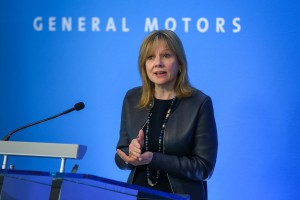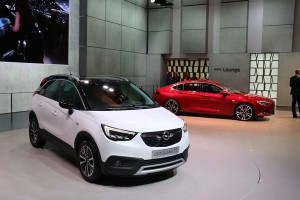(This story was corrected to reflect the Q3 2017 EBIT-adjusted income for GM and the Wall Street forecast for the quarter.)
General Motors Co. posted a $2.98 billion loss for the third quarter of 2017, its net income hammered by a $5.4 billion charge resulting from the sale of its long-troubled European subsidiary Opel/Vauxhall.
Before taxes, GM actually earned $2.5 billion, a 32% decline from the $3.7 billion EBIT-adjusted number it reported during the July-September quarter in 2016. But Detroit’s automaker nonetheless managed to beat expectations, delivering per share earnings of $1.32 after factoring for one-time charges. Wall Street analysts had forecast earnings of $1.11 per share.
Excluding the hefty cost of exiting Europe, “The way to really think about the business is obviously continuing operations and the core business,” said GM Chief Financial Officer Chuck Stevens. Significantly, all of GM’s other operations – including North America, South America, China and other parts of the world — were profitable for the first time since the fourth quarter of 2014.
The sale of the Opel/Vauxhall subsidiary was really almost two decades in the making, the carmaker having not earned a profit there since late in the 1990s despite repeated turnaround efforts.
Under CEO Mary Barra GM has chosen to exit a number of money-losing operations, including Russia, India and South Africa. But, as a result, a company that was, for the better part of a century the world’s largest automaker based on unit sales, is expected to slip to fourth on the charts going forward.
The trade-off is “to enable us on a go-forward basis to really focus our resources,” said Stevens, “on growth opportunities in the business and continuing to improve the core.”
Even without the penalty from the sale of European operations GM would have had a weak quarter, typical for the industry as sales slow during the summer months and production is trimmed in response, allowing changeovers for the new model year.
GM’s revenues dipped 13.5% for the quarter, to $33.6 billion.
North America remained GM’s powerhouse, though it reported adjusted pre-tax earnings fell to $2.1 billion as wholesale volume for the quarter dipped by 26% year-over-year. The automaker has taken a number of shifts out of its production schedule since last autumn, in part reflecting the slowdown in the overall U.S. market, but it also took steps during the quarter to trim bloated dealer inventories by 166,000 units. It ended September with an 88-day supply of vehicles, down from 104 a year earlier. And GM is targeting further reductions before the end of 2017.
“We delivered solid results even with planned, lower third-quarter production in North America,” said Chairman and CEO Barra said in a statement. “We are managing the business with discipline to drive strong performance today, while investing in higher-return opportunities, including those that will shape the future of transportation.”
The year has seen GM step up investments in a number of technologies and trends expected to reshape the future of transportation. That includes expanding its ties to the country’s second-largest ride-sharing service Lyft. Many experts believe that millions of Americans will shift away from owning personal vehicles and relying instead of ride-sharing. That’s especially likely, the logic goes, as new driverless vehicles go into production.
GM is taking a major step into that realm for the 2018 model-year with the launch of its new, semi-autonomous Super Cruise technology on the Cadillac CT6 sedan.
To go the next step, the company this month acquired Strobe, a California company developing the low-cost LIDAR, or 3D, high-definition laser, technology needed for fully autonomous and driverless vehicles.
Meanwhile, GM this month announced that it is on a path that will see it eventually abandon the internal combustion engine and rely solely on pure electric propulsion. It plans to offer at least 20 pure battery-electric models by 2023, global product chief Mark Reuss revealed at a Detroit news conference.
“Regardless of where we do biz we are committed to an all-electric future,” Barra said, during a Tuesday morning news conference, adding that this will include both battery- and hydrogen fuel-cell-powered vehicles.
Some observers question the billions of dollars GM is investing in such untested technologies, which won’t pay off for years. But CFO Stevens said there was plenty of reason to feel good about the “great progress” GM already is making, including the fact that it maintained margins of 8.3 percent for the quarter.
He left unchanged the company’s guidance for all of 2016, somewhere between $6 and $6.50 a share.
“We’re very, very much on track to deliver a very strong year,” he said. “Our 2017 results will be in line with the record results that we posted in 2016.”
After long questioning GM’s strategy, investors appear to finally be buying in, the automaker’s stock rising 30% so far this year, and showing more upward momentum in early morning trading on Tuesday.




